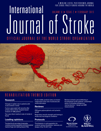Hemorrhage after ischemic stroke – relation to age and previous hemorrhage in a nationwide cohort of 58 868 patients
Abstract
Background
In randomized controlled trials of secondary prevention after stroke, the risk of hemorrhage varies between 1% and 5% per year in patients with antithrombotic therapy, i.e. anticoagulants and antiplatelets.
Aim
To explore the rate and the risk of hemorrhage after stroke in a nationwide cohort.
Methods
We identified 58 868 first ever ischemic stroke patients in the Swedish Stroke Register during 2001 to 2005 (=index stroke) and followed them by record linkage to the National Patient Register. Rates of hemorrhage and hazard ratios, for comparisons of rates between subgroups, were calculated.
Results
Of the 58 586 ischemic stroke patients identified, 5527 (9·4%) had a history of hemorrhage. During follow-up (mean 2·0 years), 2876 patients endured a hemorrhage, giving an average hemorrhage rate of 2·6 (95% confidence interval 2·5–2·7) per 100 person-years. After index stroke, 11% of the patients were discharged with anticoagulants, and 79% with antiplatelets. Given the differences in baseline characteristics, the hemorrhage rates (per 100 person-years) were 2·5 (95% confidence interval 2·2–2·8), 2·4 (95% confidence interval 2·3–2·5), and 3·8 (95% confidence interval 3·5–4·2) in patients prescribed anticoagulants, antiplatelets, and no antithrombotics, respectively. There was an increased risk of hemorrhage in patients ≥75 years compared with those <75 years (hazard ratio = 1·61, 95% confidence interval 1·49–1·73) and in patients with previous hemorrhages compared with those without (hazard ratio = 1·82, 95% confidence interval 1·64–2·02).
Conclusions
When antithrombotics were used in large-scale clinical practice, the observed rates of hemorrhage were similar with anticoagulant therapy but increased with antiplatelet therapy compared with rates reported in randomized controlled trials. Old age and previous hemorrhage were associated with an increased risk of hemorrhage after an ischemic stroke.




